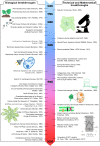Membrane voltage as a dynamic platform for spatiotemporal signaling, physiological, and developmental regulation
- PMID: 33598675
- PMCID: PMC8133626
- DOI: 10.1093/plphys/kiab032
Membrane voltage as a dynamic platform for spatiotemporal signaling, physiological, and developmental regulation
Abstract
Membrane voltage arises from the transport of ions through ion-translocating ATPases, ion-coupled transport of solutes, and ion channels, and is an integral part of the bioenergetic "currency" of the membrane. The dynamics of membrane voltage-so-called action, systemic, and variation potentials-have also led to a recognition of their contributions to signal transduction, both within cells and across tissues. Here, we review the origins of our understanding of membrane voltage and its place as a central element in regulating transport and signal transmission. We stress the importance of understanding voltage as a common intermediate that acts both as a driving force for transport-an electrical "substrate"-and as a product of charge flux across the membrane, thereby interconnecting all charge-carrying transport across the membrane. The voltage interconnection is vital to signaling via second messengers that rely on ion flux, including cytosolic free Ca2+, H+, and the synthesis of reactive oxygen species generated by integral membrane, respiratory burst oxidases. These characteristics inform on the ways in which long-distance voltage signals and voltage oscillations give rise to unique gene expression patterns and influence physiological, developmental, and adaptive responses such as systemic acquired resistance to pathogens and to insect herbivory.
© The Author(s) 2021. Published by Oxford University Press on behalf of American Society of Plant Biologists.
Figures

Similar articles
-
Voltage dependence of the carrier-mediated ion transport.Phys Rev E Stat Nonlin Soft Matter Phys. 2006 Feb;73(2 Pt 1):021902. doi: 10.1103/PhysRevE.73.021902. Epub 2006 Feb 7. Phys Rev E Stat Nonlin Soft Matter Phys. 2006. PMID: 16605357
-
VRACs and other ion channels and transporters in the regulation of cell volume and beyond.Nat Rev Mol Cell Biol. 2016 May;17(5):293-307. doi: 10.1038/nrm.2016.29. Epub 2016 Apr 1. Nat Rev Mol Cell Biol. 2016. PMID: 27033257 Review.
-
Electrochemical patterns during Drosophila oogenesis: ion-transport mechanisms generate stage-specific gradients of pH and membrane potential in the follicle-cell epithelium.BMC Dev Biol. 2019 Jun 21;19(1):12. doi: 10.1186/s12861-019-0192-x. BMC Dev Biol. 2019. PMID: 31226923 Free PMC article.
-
Regulation of Cytosolic pH: The Contributions of Plant Plasma Membrane H+-ATPases and Multiple Transporters.Int J Mol Sci. 2021 Nov 30;22(23):12998. doi: 10.3390/ijms222312998. Int J Mol Sci. 2021. PMID: 34884802 Free PMC article. Review.
-
NaV Channels: Assaying Biosynthesis, Trafficking, Function.Methods Mol Biol. 2018;1722:167-184. doi: 10.1007/978-1-4939-7553-2_11. Methods Mol Biol. 2018. PMID: 29264805 Review.
Cited by
-
Electrifying rhythms in plant cells.Curr Opin Cell Biol. 2022 Aug;77:102113. doi: 10.1016/j.ceb.2022.102113. Epub 2022 Jul 6. Curr Opin Cell Biol. 2022. PMID: 35809387 Free PMC article. Review.
-
Dynamic membranes-the indispensable platform for plant growth, signaling, and development.Plant Physiol. 2021 Apr 2;185(3):547-549. doi: 10.1093/plphys/kiaa107. Plant Physiol. 2021. PMID: 33822219 Free PMC article. No abstract available.
-
A challenge to claims for mycorrhizal-transmitted wound signaling.Plant Signal Behav. 2023 Dec 31;18(1):2222957. doi: 10.1080/15592324.2023.2222957. Plant Signal Behav. 2023. PMID: 37291867 Free PMC article. No abstract available.
-
An update on passive transport in and out of plant cells.Plant Physiol. 2021 Dec 4;187(4):1973-1984. doi: 10.1093/plphys/kiab406. Plant Physiol. 2021. PMID: 35235675 Free PMC article. Review.
-
Integration of Electrical Signals and Phytohormones in the Control of Systemic Response.Int J Mol Sci. 2023 Jan 3;24(1):847. doi: 10.3390/ijms24010847. Int J Mol Sci. 2023. PMID: 36614284 Free PMC article. Review.
References
-
- Abe T (1981) Chloride-ion efflux during an action-potential in the main pulvinus of mimosa-pudica. Bot Mag-Tokyo 94:379–383
-
- Abe T, Oda K (1976) Resting and action potentials of excitable cells in main pulvinus of mimosa-pudica Plant Cell Physiol 17:1343–1346
-
- Alpi A, Amrhein N, Bertl A, Blatt MR, Blumwald E, Cervone F, Dainty J, De Michelis MI, Epstein E, Galston AW, et al. (2007) Plant neurobiology: no brain, no gain? Trends Plant Sci 12:135–136 - PubMed
Publication types
MeSH terms
Substances
Grants and funding
- BB/D001528/1/BB_/Biotechnology and Biological Sciences Research Council/United Kingdom
- BB/P011586/1/BB_/Biotechnology and Biological Sciences Research Council/United Kingdom
- P12750/BB_/Biotechnology and Biological Sciences Research Council/United Kingdom
- BB/L019025/1/BB_/Biotechnology and Biological Sciences Research Council/United Kingdom
- BB/H009817/1/BB_/Biotechnology and Biological Sciences Research Council/United Kingdom
- BB/F001630/1/BB_/Biotechnology and Biological Sciences Research Council/United Kingdom
- BB/F001673/1/BB_/Biotechnology and Biological Sciences Research Council/United Kingdom
- BB/C500595/1/BB_/Biotechnology and Biological Sciences Research Council/United Kingdom
- BB/N01832X/1/BB_/Biotechnology and Biological Sciences Research Council/United Kingdom
LinkOut - more resources
Full Text Sources
Other Literature Sources
Miscellaneous

